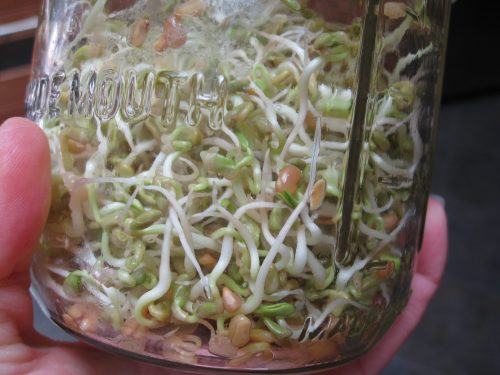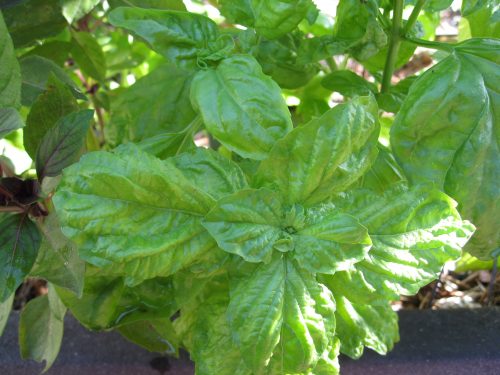A great question came into Ask Gardenerd this week:
“Do you have any tips on getting rid of root rot nematodes? Thanks! – Max“
There are natural ways to rid or drastically reduce your soil of pesky nematodes, Max. But first a clarifying question: when you say “root rot nematodes” did you mean “root knot nematodes?” Root rot is usually caused by something else, like a fungus or by critters like beetle grubs eating the roots. Root knot, on the other hand, is the condition when the root systems of your plants develop galls all over them. Galls are enlarged, warty-looking knots on your roots that have actually become a home for root knot nematodes. Those galls (and those nematodes) block the uptake of nutrients, so plants become stunted or die.
We’ve written about nematodes before, and even done a podcast about them (find the link in said blog post), so there are some resources you can utilize to research a solution. In our own garden, we had trouble with nematodes stunting our tomato plants. We didn’t use the shrimp shell meal that was mentioned in the podcast, we just grew nematicidal marigolds and it helped for awhile. They seem to be back now, so it’s time to grow them again.
One gardener out there used a combination of shrimp shell meal, beneficial nematodes and nematicidal marigolds to conquer the problem. Seems to have worked for him. Here is what UC Davis has to say about pest management:
“Certain marigolds, Tagetes species, suppress root knot and lesion nematodes. French marigolds (varieties include Nemagold, Petite Blanc, Queen Sophia, and Tangerine) are most effective. Avoid signet marigolds, T. signata or tenuifolia, because nematodes will feed and reproduce on these. Marigolds don’t work well against the northern root knot nematode, Meloidogyne hapla, a species common in areas with cool winters. The effect of marigolds is greatest when you grow them as a solid planting for an entire season. When grown along with annual vegetables or beneath trees or vines (intercropping), nematode control usually isn’t very good. To prevent marigold seed from getting in the soil, cut or mow the plants before the flowers open. As with other cultural control methods, nematode populations rapidly will increase as soon as you grow susceptible crops again.”
Some Other Suggestions
There are some predatory nematode products on the market that inoculate your soil with the kind of nematodes that eat the bad ones. University data seems to show these as being ineffective (or at least they state that research showing that it works isn’t currently available) . That said, ACT or Active Compost Tea is a great addition to your soil for any microorganism issue. Compost tea that has been brewed with a food source and aerated for 24-48 hours is chock full of beneficial microbes that destroy pests.
UC IPM recommends solarizing your soil to heat-kill those bad microbes. We’re not big fans of drying out the soil and baking it (kills beneficials as well as pests), but in a pinch, it’s effective (on one forum, we found a gardener who puts down cardboard on the affected area, sets it on fire to heat-kill. He stands by with a hose just in case.) UC IPM also recommend letting your soil go fallow for a season or two to starve pests out.
The final suggestion is to grow resistant varieties. This document shares some cultivars that are proven resistant to nematodes. They aren’t heirlooms or open pollinated varieties, but it’s a step you can take on a temporary basis as you use other methods to get rid of the nematodes.
We hope you find this info helpful, Max. Gardenerds, weigh in if you have other suggestions that have worked for you.





I have a friend who’s a Barber and also a home gardener. he swears by putting human hair abundantly before planting in his raised bed soil help to eliminate or help to control root knot nematodes tremendously. He places about three handful per plant under his tomatos plants. Best of all it’s completely free and recycle or upcycle something that would have been thrown out anyway. Try and let us.
Interesting approach. I’ve used pet hair for keeping squirrels away (with only moderate success), but we’ll have to give this one a test. Thanks for sharing!
I have been dealing with nematodes for years, combating them using only organic methods, and now have them under control – not gone mind you, but under control to the point I get a good harvest off all my plants, and this year my tomato plants had almost no root galls!!
What I do: I rotate my crops by family – I have 5 beds, so I have a 5 year rotation. Each summer I take one bed out of circulation and do trench vermiposting to increase the organic matter (humus) in that bed. Humus improves soil structure and the ability of the soil to hold nutrients and water, strengthening plants subsequently grown in the bed, and RKN have a harder time of it with humusy soil. The first winter following the vermipost cycle I plant brassicas, which are heavy feeders, followed by solanaceae in the spring, which are pretty sensitive to RKN. I add shrimp meal to my beds annually along with the granular veggie fertilizer which is applied each season (Shrimp meal helps increase the population of bacteria that feed on nematode eggs and otherwise improves the soil). I apply beneficial nematodes (Steinernema feltiae from BioLogic) in the spring every 2 years. I plant susceptible plants like tomatoes as early as possible in the spring – if you can get your susceptible crops in early they can grow healthy roots and you can start harvesting before the plant gets weakened too much (RKN proliferate in warmer weather). If you have a fall season, wait until the soil cools a bit before putting in your new plants. At the end of the season I remove spent plants as soon as they are done, getting out as many roots as I can. Don’t compost RKN infested roots. I plant some nematode resistant tomatoes and peppers each year (hybrid VFN varieties). If for some reason the nematodes are aggressive in the bed in a given year the VFN plants will guarantee a harvest. If you have an RKN infestation trying to only grow heirloom tomato varieties will only end in tears – get things in hand, then you can grow them again (I do half and half these days). I grow various root crops like potatoes and garlic but I never save any for planting later, I get new seed stock each year so I don’t plant already infested stock. I have never tried solarization or marigolds. Solarization is a short-term fix, and you have to take a bed out of circulation during prime growing time – I do take one out of circulation each summer, but I am feeding the soil for a longer term benefit. Marigolds – Only some varieties will work, some will make it worse, and you have to use them in a very particular way, taking your garden out of commission for a season, planting jillions of them, making sure there are no weeds, tilling (which is pretty tricky in high raised beds LOL), getting the timing just so…it’s complicated to get right, and again, the results are short-lived.
There isn’t a cheap, easy magic bullet, but with diligence and time (and a bit of record keeping) you can knock RKN back to a workable level. I was absolutely thrilled this year when one tomato plant after another came out with almost clean roots.
Thanks for adding your own strategy to the mix, Elizabeth. It’s a great list of To-Dos with nematode-infested beds.
Did we ever get an update from Max on how things went after his second try with planting Marigolds? And have any new research been published on how to fight root knot nematodes since this post in 2014?
Good question, Kate. Maybe Max will chime in and report back. Arbico Organics lists a few new items in their arsenal for root nematodes, in addition to crab meal. Check them out:
Christy – thanks for taking the time to respond to my question on root KNOT nematodes. I’ve tried in the past , without much success, marigolds, solarization, and ground shrimp shells. Per your suggestion, I’ll try a denser planting (no intermingled veggies!) of the specific marigold varieties you mentioned this coming Spring and hope for the best.
Max
Good luck, Max. Keep us posted on your results.